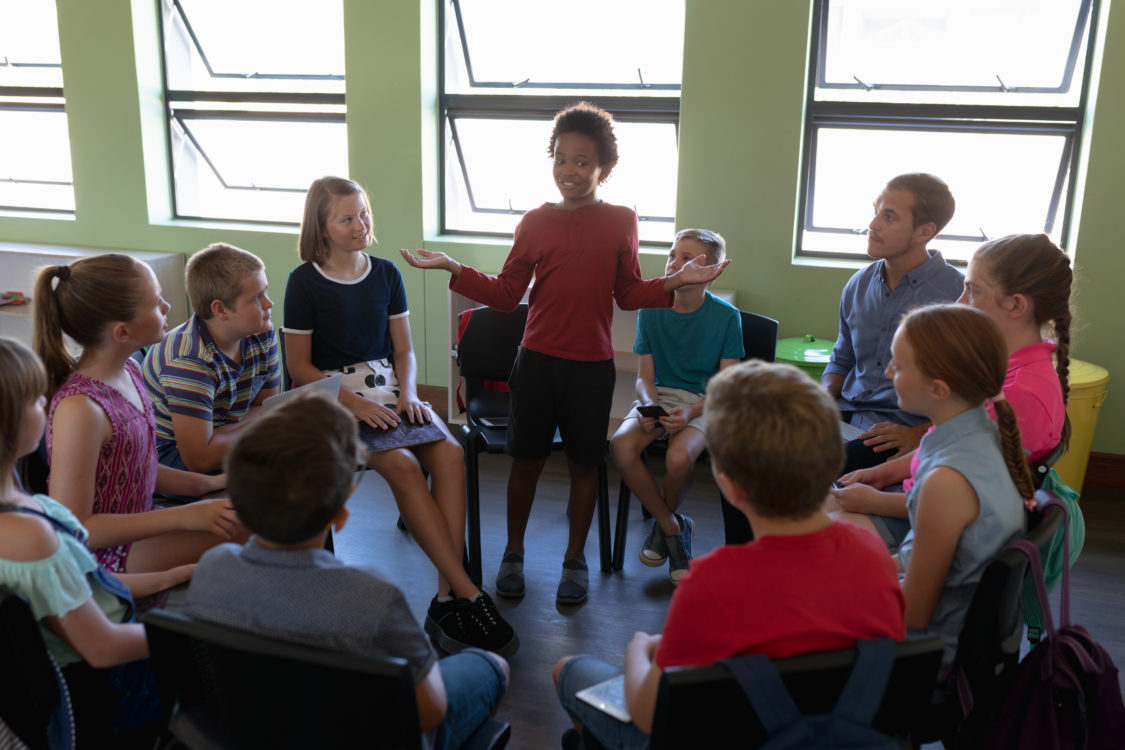Joey was a second-grade student at Bailey’s Elementary School. During independent reading, from time to time, I’d glance over and see Joey manipulating his hands as he reenacted the latest scene from his action-packed Pokémon adventures. Joey, like many children, sought to tell or reenact stories from his experiences. At times, these stories were a blend of video games or television reenactments while other times the stories captured a memory.
Storytelling is a powerful instructional tool in our classrooms.
Storytelling acknowledges students for who they are and provides space for students to share their experiences in the world. “Through the stories students share, they let us know their worlds, so we listen, pay attention, and continue to carve out space where they can talk their way into stories in the company of an audience who values what they have to say.” (Horn, Giacobbe, 2007, p. 11). In doing so, classrooms can become a learning community where all voices and experiences are valued. In primary classrooms, storytelling also serves as a tool to support early literacy learning by nurturing a sense of story and oral language development. I will outline ways you can support and enrich storytelling in your classroom.
Encourage
To create a safe and nurturing environment be flexible and adaptable in how you engage students in storytelling. Model for students a variety of ways to tell a story. This could be oral storytelling, or storytelling with the use of stuffed animals, puppets, storyboards, photos, drawings or a dramatic representation. Invite and allow students to choose how they would like to share their stories.
Another way to invite students into storytelling is through a shared class experience. The class shared experience can be as big as making pancakes or a class game of duck-duck goose outside. Or the shared experience can be found in the multitude of funny little things which happened each and every day in the classroom, like when the teacher tripped on the rug or of course that cockroach that ran across the morning meeting carpet.
Students will delight in recreating a shared class experience and will form a sense of togetherness by jointly retelling the story.
Honor Prior Knowledge
Students come to school with a wealth of family and cultural backgrounds and many will understand stories and story structures in different ways. Some cultures tell stories which have been passed down through centuries; or tell stories about family histories which have been passed through the generations.
Nicole Gardner-Neblett’s article, “Why Storytelling Skills Matter for African-American Kids” cites that, “studies have found that African American children have a wide repertoire of storytelling styles, which they use flexibly depending on the context.”
Rather than narrowing the lens through which students share their stories, give students space to be expressive and experiment with storytelling. Support students with expanding their storytelling by inquiring about what a person or characters said, and how they said it, or express curiosity in where the story took place. Use language like, “I’m trying to picture this in my head, can you tell us about…” or “what did you say/feel/think when…”
It is important to appreciate and promote the unique and joyful ways students share their stories with classmates.
Listen
Storytelling places a high cognitive demand on young students as they engage in the complex work of shaping and generating language to express their story. It is important to accept a variety of cultural dialects.
If students are dual language learners, accept students’ stories in their first language until students initiate their stories in English. When students attempt English, see the value in language and pronunciation approximations. So rather than listening to correct grammar, listen to extend the meaning of the students’ stories. Listen to understand why the story is meaningful to the student and to understand how the story reflects the students’ interest or experience in the world. When a student needs support, nurture his oral language development to enhance meaning.
Support students with vocabulary by naming the new or unfamiliar object or place for the students. Another way to extend meaning is to mirror and lift the students’ language approximation. For instance, if a student speaks in a short utterance you might mirror and lift the students’ utterances. For example, if a student said “bee in room” you might say “There was a bee in your room. What happened?” In doing so we listen and value what the student has attempted to say and then provide a model of how to extend just a bit further what the student can say on their own in order to enhance the meaning of their story.
Storytelling provides space and time for students to say, I am here, and I matter.
It provides space for students to find and use their voice. It opens opportunities for classmates and teachers to learn about the uniqueness of each student’s family, friends, culture, and individual experiences of the world. Through storytelling students will also gain a sense of story and expand oral language. Furthermore, storytelling invites students to engage in the writing process. Students are active in the writing process as they generate story ideas, draft and revise for clarity and gain a sense of purpose and audience.
If nothing else, remember the role of the teacher is to foster the students’ sense of pride in themselves.
Nicole Gardner-Neblett’s, Why Storytelling Skills Matter for African-American Kids, TheConversation.com
Horh, Martha & Giacobbe Mary Ellen. (2007). Talking, Drawing, Writing Lessons for Our Youngest Writers. Portland, Maine: Stenhouse Publishers.





